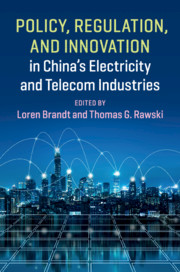Book contents
- Policy, Regulation, and Innovation in China’s Electricity and Telecom Industries
- Policy, Regulation, and Innovation in China’s Electricity and Telecom Industries
- Copyright page
- Contents
- Figures
- Tables
- Contributors
- Acknowledgments
- Abbreviations
- Map of China
- 1 Policy, Regulation, and Innovation in China’s Electricity and Telecom Industries
- 2 China’s Electricity and Communications Regulation in Global Context
- 3 Local Government and Firm Innovation in China’s Clean Energy Sector
- 4 Technology Integration in China’s Electricity System: Central Targets and Local Challenges
- 5 When Global Technology Meets Local Standards
- 6 The Search for High Power in China: State Grid Corporation of China
- 7 Growth, Upgrading, and Limited Catch-Up in China’s Semiconductor Industry
- 8 Growth, Upgrading, and Excess Cost in China’s Electric Power Sector
- 9 China’s Development of Wind and Solar Power
- 10 Capability Upgrading and Catch-Up in Civil Nuclear Power: The Case of China
- Index
- References
2 - China’s Electricity and Communications Regulation in Global Context
Published online by Cambridge University Press: 08 June 2019
- Policy, Regulation, and Innovation in China’s Electricity and Telecom Industries
- Policy, Regulation, and Innovation in China’s Electricity and Telecom Industries
- Copyright page
- Contents
- Figures
- Tables
- Contributors
- Acknowledgments
- Abbreviations
- Map of China
- 1 Policy, Regulation, and Innovation in China’s Electricity and Telecom Industries
- 2 China’s Electricity and Communications Regulation in Global Context
- 3 Local Government and Firm Innovation in China’s Clean Energy Sector
- 4 Technology Integration in China’s Electricity System: Central Targets and Local Challenges
- 5 When Global Technology Meets Local Standards
- 6 The Search for High Power in China: State Grid Corporation of China
- 7 Growth, Upgrading, and Limited Catch-Up in China’s Semiconductor Industry
- 8 Growth, Upgrading, and Excess Cost in China’s Electric Power Sector
- 9 China’s Development of Wind and Solar Power
- 10 Capability Upgrading and Catch-Up in Civil Nuclear Power: The Case of China
- Index
- References
Summary
This chapter addresses five regulatory challenges in China’s electricity and communications markets and compares them to global practice. First, while China’s regulators are separate from operators, they often support the government’s goals of promoting state-owned enterprises over private and foreign firms, and national companies over local ones.
Second, firms in China enter and exit the market under significant government guidance, which can distort competition and decrease productivity.
Third, the goals of communications interconnection and electricity transmission and distribution regulation to promote market efficiency and economic growth can conflict with government’s ambitions that state-owned enterprises achieve international prestige.
Fourth, other issues compete with regulatory goals. Environmental policy influence electricity regulation. Ideological concerns about foreign and subversive media content influences communication regulation, especially Internet industries.
Finally, other chapters in this volume show the innovation in China’s nuclear power generators and ultra-high voltage transmission industries. These industries’ willing compliance with international safety regulation contributes to their export success. China has adopted many regulatory approaches considered best practice in today’s electricity and communications circles. At the same time, the government’s tendency to short circuit market competition by picking winners can undermine the benefits of these best practice approaches.
This study analyzes China’s telecommunications and electricity sector from three perspectives – market reforms, regulatory reforms, and their intersection with major challenges – and places each in a global context. Market reforms include changes in market structure, both globally and in China. Regulator reforms include changes in governance structure, both globally and in China, along with price reform. For telecom, the intersection is with Internet and media; for electricity, with the environment. China has implemented reforms in both sectors with significant success in terms of massive investment and increased subscribership. However, in both sectors there are longstanding problems that if unresolved will have significant opportunity costs in terms of growth and innovation.
Keywords
- Type
- Chapter
- Information
- Publisher: Cambridge University PressPrint publication year: 2019

